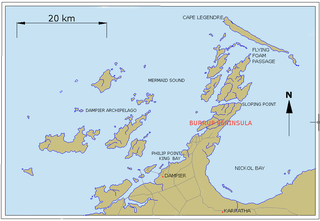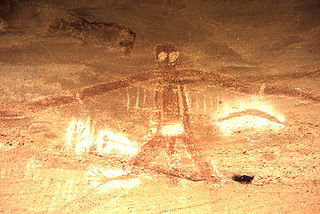
Protected areas of South Australia consists of protected areas located within South Australia and its immediate onshore waters and which are managed by South Australian Government agencies. As of March 2018, South Australia contains 359 separate protected areas declared under the National Parks and Wildlife Act 1972, the Crown Land Management Act 2009 and the Wilderness Protection Act 1992 which have a total land area of 211,387.48 km2 (81,617.16 sq mi) or 21.5% of the state's area.

The Jervis Bay Territory is an internal territory of Australia. It was established in 1915 from part of New South Wales (NSW), in order to give the landlocked Australian Capital Territory (ACT) access to the sea.

Dhilba Guuranda–Innes National Park, formerly Innes National Park, is an IUCN-designated protected area in the Australian state of South Australia located on the southwest tip of Yorke Peninsula about 300 kilometres (190 mi) west of the state capital of Adelaide. It is a popular destination for camping, bushwalking, fishing, surfing and scuba diving.

A shipwreck is the wreckage of a ship that is located either beached on land or sunken to the bottom of a body of water. Shipwrecking may be intentional or unintentional. There were approximately three million shipwrecks worldwide as of January 1999, according to Angela Croome, a science writer and author who specialized in the history of underwater archaeology.

Wreck diving is recreational diving where the wreckage of ships, aircraft and other artificial structures are explored. The term is used mainly by recreational and technical divers. Professional divers, when diving on a shipwreck, generally refer to the specific task, such as salvage work, accident investigation or archaeological survey. Although most wreck dive sites are at shipwrecks, there is an increasing trend to scuttle retired ships to create artificial reef sites. Diving to crashed aircraft can also be considered wreck diving. The recreation of wreck diving makes no distinction as to how the vessel ended up on the bottom.

The Neptune Islands consist of two groups of islands located close to the entrance to Spencer Gulf in South Australia. They are well known as a venue for great white shark tourism.
Aviation archaeology is a recognized sub-discipline within archaeology and underwater archaeology as a whole. It is an activity practiced by both enthusiasts and academics in pursuit of finding, documenting, recovering, and preserving sites important in aviation history. For the most part, these sites are aircraft wrecks and crash sites, but also include structures and facilities related to aviation. It is also known in some circles and depending on the perspective of those involved as aircraft archaeology or aerospace archaeology and has also been described variously as crash hunting, underwater aircraft recovery, wreck chasing, or wreckology.

The Environment Protection and Biodiversity Conservation Act 1999(Cth) is an Act of the Parliament of Australia that provides a framework for protection of the Australian environment, including its biodiversity and its natural and culturally significant places. Enacted on 17 July 2000, it established a range of processes to help protect and promote the recovery of threatened species and ecological communities, and preserve significant places from decline. The Act is as of June 2020 administered by the Department of Agriculture, Water and the Environment. Lists of threatened species are drawn up under the Act, and these lists, the primary reference to threatened species in Australia, are available online through the Species Profile and Threats Database (SPRAT).

The Protection of Military Remains Act 1986 is an Act of Parliament in the United Kingdom that provides protection for the wreckage of military aircraft and designated military vessels. The Act provides for two types of protection: protected places and controlled sites. Military aircraft are automatically protected, but vessels have to be specifically designated. The primary reason for designation is to protect as a 'war grave' the last resting place of British servicemen ; however, the Act does not require the loss of the vessel to have occurred during war.

Murujuga, formerly known as Dampier Island and today usually known as the Burrup Peninsula, is an area in the Dampier Archipelago, in the Pilbara region of Western Australia, containing the town of Dampier. The Dampier Rock Art Precinct, which covers the entire archipelago, is the subject of ongoing political debate due to historical and proposed industrial development. Over 40% of Murujuga lies within Murujuga National Park, which contains within it the world's largest collection of ancient 40,000 year old rock art (petroglyphs).

A wild river or heritage river (Canada) is a river or a river system designated by a government to be protected and kept "relatively untouched by development and are therefore in near natural condition, with all, or almost all, of their natural values intact."

An Australian Aboriginal sacred site is a place deemed significant and meaningful by Aboriginal Australians based on their beliefs. It may include any feature in the landscape, and in coastal areas, these may lie underwater. The site's status is derived from an association with some aspect of social and cultural tradition, which is related to ancestral beings, collectively known as Dreamtime, who created both physical and social aspects of the world. The site may have its access restricted based on gender, clan or other Aboriginal grouping, or other factors.
Australian heritage laws exist at the national (Commonwealth) level, and at each of Australian Capital Territory, New South Wales, Northern Territory, Queensland, South Australia, Tasmania, Victoria, Western Australia state and territory levels. Generally there are separate laws governing Aboriginal cultural heritage and sacred sites, and historical heritage. State laws also allow heritage to be protected through local government regulations, such as planning schemes, as well.
The Aboriginal Heritage Act 1988 (AHA) is the principal South Australian legislation protecting and preserving the state's Aboriginal heritage. It repealed and replaced the Aboriginal and Historic Relics Preservation Act 1965, which was the first state legislation to protect Aboriginal Australian heritage in Australia.

Loch Vennachar was an iron-hulled, three-masted clipper ship that was built in Scotland in 1875 and lost with all hands off the coast of South Australia in 1905. She spent her entire career with the Glasgow Shipping Company, trading between Britain and Australia. The company was familiarly called the "Loch Line", as all of its ships were named after Scottish lochs. The ship was named after Loch Venachar, in what was then Perthshire.
The Australasian Underwater Cultural Heritage Database (AUCHD) is an online, searchable database containing data on shipwrecks, aircraft that have been submerged underwater or wrecked on the shore, and other artefacts of cultural significance which are or have been underwater. It includes what used to be called the Australian National Shipwreck Database (ANSDB), originally developed by the Australasian Institute of Maritime Archaeology in December 2009, now significantly expanded to include other objects. The database was hosted and maintained by the Department of the Environment and Energy until the environment functions of that department, including AUCHD, were taken over by the Department of Agriculture, Water and the Environment on 1 February 2020.

The Aboriginal and Torres Strait Islander Heritage Protection Act 1984(Cth), is an Act passed by the Parliament of the Commonwealth of Australia to enable the Commonwealth Government to intervene and, where necessary, preserve and protect areas and objects of particular significance to Australia's Aboriginal or Torres Strait Islander peoples from being desecrated or injured.

The Historic Shipwrecks Act 1976 was an Act of the Parliament of Australia which legally protected historic shipwrecks and any relics or artefacts from those wrecks.
The Department of the Environment and Energy (DEE) was an Australian government department in existence between 2016 and 2020.













